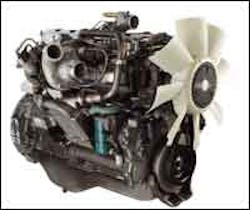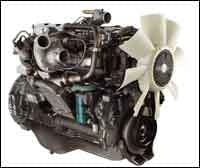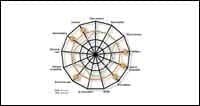CI-4 Oil: Chemistry, Choices And Concerns
Do you spend time thinking about the cost of engine oil and how often to change it? If so, you probably know all about CI-4. But if you think about changing oil only when your dealer reminds you it's time, then CI-4 might be an unfamiliar term.
So, to put us all on equal footing, CI-4 is the designation that the American Petroleum Institute (API) has given to North America's newest oil for use in four-stroke-cycle diesel engines. Although CI-4 was developed specifically for truck engines running with cooled-EGR (a new emissions-control system), it replaces preceding oils, so CI-4 is likely the lubricant you're now buying for your diesels.
Whether you buy oil in bulk directly from a jobber, or buy it indirectly when the dealer services your machine, you have choices to exercise about CI-4 products. The more you know about CI-4, then, the more advised can be your choices. To that end, our discussion here will cover basic CI-4 chemistry (so you can better understand what marketers say about their products); the selection of products available; the new oil's probable affect on drain intervals; and a brief look at potential—and we emphasize potential—concerns about the new oil.
As you may know, cooled EGR (exhaust gas recirculation) was the primary technology chosen by five major engine manufacturers to bring their truck engines into compliance with the Environmental Protection Agency's October 2002 regulation for smog-producing nitrogen oxides (NOx). Briefly, cooled-EGR is a technique that recirculates a portion of diesel's exhaust back through the cylinders to lower combustion temperatures, which, in turn, retards the formation of (NOx).
The potential liability of cooled-EGR, though, is that engine health could be jeopardized by harmful elements in the recirculated exhaust, namely metal-corroding acids and soot, mostly partially burned fuel and oil, which induces wear and thickens oil.
Plus, the heat dumped into the engine's coolant from the EGR system can potentially cause harm. Since exhaust temperature is reduced from around 1,200F to 250F before being piped back to the cylinders, the hotter coolant can make the engine and its oil run hotter. The consequence is that hotter oil oxidizes more readily; that is, its hydrogen and carbon compounds combine more rapidly with oxygen to form varnish and sludge.
Concerned about the ability of then current CH-4 oil (CI-4's predecessor) to protect cooled-EGR engines from potentially higher levels of acid, soot and oxidation, the Engine Manufacturers Association (EMA) requested a new oil category. The process behind establishing parameters and tests for the new oil was complex, but when oil companies were given the performance expectations for the new oil, they went to work.
"Once performance specifications are set for a new oil, how those standards are attained is up to the oil company," says Shell Oil Co.'s Peter Van Benthuysen. "It's a process that allows creativity in providing performance at a reasonable cost."
Although developed with cooled-EGR engines in mind, CI-4's formulators did not forget about older engines. The new oil is "backward compatible." That means, according to a technical paper presented at the 8th Annual Fuels and Lubes Asia Conference last year, "it should provide adequate protection for new EGR diesel engines, those using the HEUI (hydraulic/electronic unit injector) fuel system, and all other existing diesel engines."
Engine oil has two basic ingredients: base oil (or base stock) and an additive package (or additive system). Sounds simple enough, but the chemistry involved is extremely complex, and variations in base-stock blends and additive systems make for a wide range of products, all identified as CI-4, but with potentially quite dissimilar formulation fingerprints.
Base stocks are fluids that serve as the oil's foundation and as the carrier for the additive system. These fluids are classified into five groups. Briefly, Groups 1, 2 and 3 are refined from crude oil and differ mainly in their sulfur content, viscosity index (how viscosity changes with temperature) and their saturate level, that is, the level of hydrocarbons saturated with hydrogen (and thus exhibiting increased stability). Groups 4 and 5 are chemically engineered, with Group 4 stocks often used in synthetic oil (as is Group 3), and with Group 5 used mainly in formulating additives.
According to Matt Urbanak, who is instrumental in formulating engine lubes for Shell, most conventional CI-4 oils contain blends of Group 1 and 2 base stocks, as did CI-4's predecessors. The bases may be balanced in a different manner, he says, but the technology is fundamentally the same.
Blended into the base stock is the additive system, a combination of varied compounds aimed at protecting the engine and prolonging the oil's life.
"Formulating is an art," says Shell's Van Benthuysen, "a matter of selecting additives that are complementary. And unless they are precisely balanced and in the right base stocks, there could be an antagonism that may jeopardize performance."
Although oil companies didn't have much information about how extensively cooled-EGR would tax a diesel's oil, most reasoned that the additives most critical in new formulations were those that could do a good job at neutralizing acids (detergents), keeping soot at bay (dispersants) and resisting sludge formation (anti-oxidants).
Detergents are compounds of alkaline metal, commonly calcium and magnesium, which have the primary job of neutralizing acid, but may help control varnish, deposits and oxidation. Dispersants, normally used with detergents, are non-metallic compounds that work to keep soot dispersed and suspended, but may have mild acid-neutralizing capability. Anti-oxidants are compounds with the primary job of retarding oil oxidation, but also can possess acid-fighting capability by controlling the acid reaction. Anti-oxidants, though, tend to be expensive additives.
"The more robust and aggressive additive characteristics of CI-4 oil," says Mark Betner, heavy-duty oil manager for CITGO Petroleum, "was targeted toward handling soot, acid and heat—in essence, to help maintain both established drain intervals and engine life. Saying the additive package is more robust means not only a higher treat level, but also that additives are more effective. Dispersant systems, for example, have improved, as have anti-oxidant and detergent systems."
Although the API does not recognize degrees of quality in CI-4 oils, most oil manufacturers give buyers a choice of "tiered" conventional products. Your choice of products should be based on your equipment-management goals, and your choices should obviously be reevaluated if your goals change.
For instance, the least expensive CI-4 oil in a manufacturer's line may appeal to cost-conscious buyers in the fleet market. Or, this oil also may appeal to machine owners who adhere to the equipment manufacturer's typically conservative oil-drain intervals, and who don't keep machines long enough to encounter engine rebuilds.
On the other hand, if an equipment owner's goal is to extend drain intervals as far as possible without damaging the engine, or to maximize engine life, then the manufacturer's premium oil might be the best choice. Premium oil may use more of the additive system present in the less expensive oil or, more likely, may use a differently formulated additive package.
Premium oil must either meet engine-maker specifications that exceed API standards for one or more of the 15 mandatory CI-4 tests, or the oil must satisfy requirements in addition to standard CI-4 tests. Sometimes both criteria must be met. For example, if an oil is to qualify for Mack's EO-N Premium Plus specification, one of the most rigorous, then it must pass CI-4 tests that address wear in critical areas of a cooled-EGR engine (liners, rings and valve train) with a significantly higher grade than the API norm. In addition, Mack imposes certain base-oil viscosity and film-thickness requirements, as well as requirements for high-temperature, high-shear performance that standard CI-4 tests do not address.
CI-4 also is available as a "universal oil," which works equally well in both diesel and gasoline engines. If you have a mixed fleet, chances are that you're already using universal oil, since most major-brand oils carry the both API CI-4 designation and the "SL" designation, which signifies the oil's suitability for gas engines. But if you're using two oils, you might want to talk to an oil supplier.
You also may want to investigate synthetic oils. Synthetics generally are oils made with a Group 3 or Group 4 base stock, while a synthetic blend usually is a Group 3 or 4 oil with a certain proportion of a Group 1 or 2 base stock mixed in. Blends are moderately more expensive than conventional oils, while Group 4 synthetics may cost up to four times more than conventional oil. Some say that synthetic blends are a bargain, providing many "true synthetic" benefits at a reasonable cost.
Synthetic oils are characterized by molecules that are similar in structure, compared to the varied molecular structures present in Group 1 and 2 base stocks. As a result, says Al Roush, director of research and development at DA Lubricants, synthetic oils are more resistant to oxidation and have excellent low-temperature properties. But opinions vary widely regarding just how much synthetic oil can reduce wear or extend drain intervals, compared to conventional oil.
CITGO's Betner admits that synthetic oil isn't for everyone, but encourages both truck and equipment owners to consider its advantages. Synthetic heavy-duty engine oil, he says, can change the world for a diesel operating in a cold climate. It can provide a 25F to 30F start-up advantage, reduce start-up wear and, because the engine fights less against stiff oil, can improve fuel efficiency and lengthen starter and battery life. And, although drain intervals with synthetics are a point of contention, some fleet managers report significantly extended intervals using heavy-duty synthetics, compared to conventional oil.
"It's probably safe to say that the improvement in quality from CH-4 to CI-4 oils, "says Van Benthuysen, "allows people with non-EGR engines the opportunity to extend drain intervals and to take advantage of CI-4's better performance. But we don't recommend a haphazard approach, because there are many implications to extending intervals beyond what the manufacturer recommends."
And, says Shell's Urbanak, always use an oil-analysis program when attempting to extend drain intervals. Get the oil supplier involved in the process as well, he says, just as check that actions do not take the process in the wrong direction in terms of risk. Most in the oil industry also agree that drain intervals for trucks with cooled-EGR systems can remain as established for CH-4 oil. But all advise a cautious approach, with oil analysis being a constant monitor of oil condition and engine wear as the industry continues to gather data on the specific performance characteristics of CI-4.
If you've reviewed product data sheets for engine oil, you've seen the terms Total Base Number (TBN) and Sulfated Ash. TBN, in layman's terms, is a measure of oil's ability to neutralize acid, and its TBN value is linked primarily to its detergency level. Sulfated ash, on the other hand, is a measure of the metallic residue (like calcium) that's left behind by detergents when oil is carbonized (partially burned). Typical TBN values may range from 9 to 15, and sulfated ash percentages from 1.1 to 1.8.
"The challenge in formulating an oil is to have moderate to high TBN to neutralize acids, but also to keep the sulfated ash low," says Jim Burke, off-road marketing manager for Castrol Heavy Duty Lubricants. "That effectiveness depends on the overall formulation of the oil and the specific technology involved. We do not recommend basing oil-change intervals on just one criterion, such as TBN. Rather, the equipment user should look at multiple criteria, such as Total Acid Number (TAN), viscosity and wear metals."
Typically, but not always, the sulfated-ash percentage goes up with the oil's TBN, and ash content has become a point of potential concern in the engine-manufacturing and oil-formulating communities.
Some say that the higher the oil's sulfated-ash percentage, the greater is its potential to leave deposits, which can foul piston rings (with a consequent loss of oil control) and can contribute to exhaust particulate matter, which the EPA also regulates. But, say others, the amount of ash an oil leaves is a function of its total formulation, the type of additives employed and the oil-burning characteristics of the engines in which it's used. The latter might say that most ash deposits follow loss of oil control.
Besides piston deposits, the EMA has told API that other potential concerns are in the areas of oil-viscosity soot control and shear stability (the ability of the oil to stay in grade as it shears through the engine). A panel of experts, under the auspices of the American Society for Testing and Material (ASTM) is looking into the matter. Whether this investigation results in any changes to CI-4 is anyone's guess.
In the meantime, the majority of the industry is pleased with CI-4. Says one engine manufacturer: "We're getting superior products at very low prices, considering the huge expense oil companies incur in testing oils as they bring them to market."


